wheel torque PORSCHE PANAMERA 2010 1.G Information Manual
[x] Cancel search | Manufacturer: PORSCHE, Model Year: 2010, Model line: PANAMERA, Model: PORSCHE PANAMERA 2010 1.GPages: 80, PDF Size: 6.26 MB
Page 6 of 80
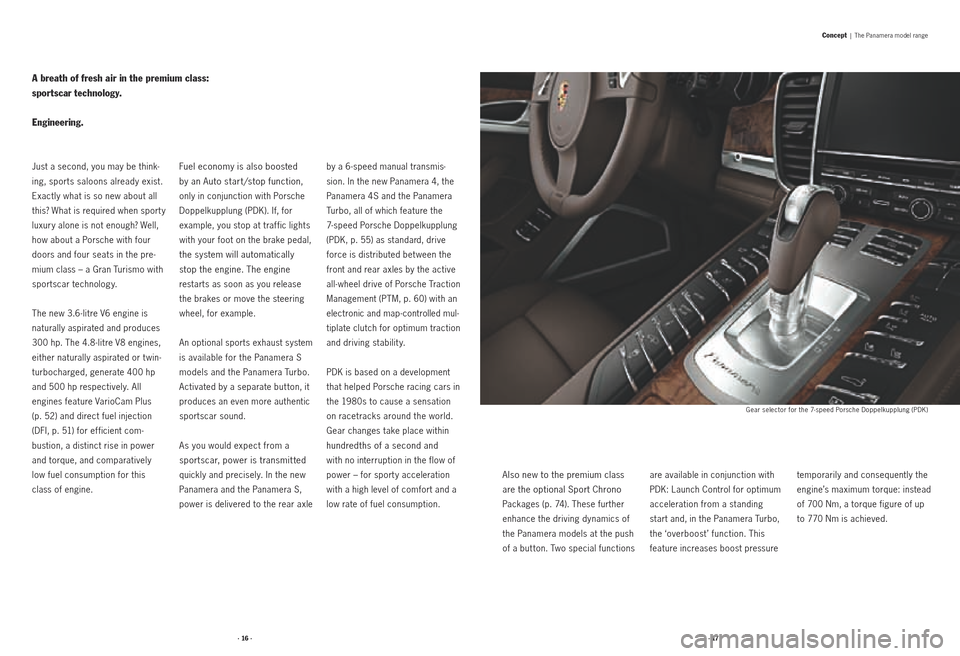
· 16 ·· 17 ·
Just a second, you may be think-
ing, sports saloons already exist.
Exactly what is so new about all
this? What is required when sport y
luxury alone is not enough? Well,
how about a Porsche with four
doors and four seats in the pre -
mium class – a Gran Turismo with
sportscar technology.
The new 3.6 -litre V6 engine is
naturally aspirated and produces
300 hp. The 4.8-litre V8 engines,
either naturally aspirated or t win-
turbocharged, generate 400 hp
and 500 hp respectively. All
engines feature VarioCam Plus
(p. 52) and direct fuel injection
(DFI, p. 51) for efficient com -
bustion, a distinct rise in power
and torque, and comparatively
low fuel consumption for this
class of engine.
A breath of fresh air in the premium class:
sportscar technology.
Engineering.
Fuel economy is also boosted
by an Auto start /stop function,
only in conjunction with Porsche
Doppelkupplung (PDK). If, for
example, you stop at traf fic lights
with your foot on the brake pedal,
the system will automatically
stop the engine. The engine
restarts as soon as you release
the brakes or move the steering
wheel, for example.
An optional sports exhaust system
is available for the Panamera S
models and the Panamera Turbo.
Activated by a separate but ton, it
produces an even more authentic
sportscar sound.
As you would expect from a
sportscar, power is transmit ted
quickly and precisely. In the new
Panamera and the Panamera S,
power is delivered to the rear axle by a 6-speed manual transmis
-
sion. In the new Panamera 4, the
Panamera 4S and the Panamera
Turbo, all of which feature the
7-speed Porsche Doppelkupplung
(PDK, p. 55) as standard, drive
force is distributed bet ween the
front and rear axles by the active
all-wheel drive of Porsche Traction
Management (PTM, p. 60) with an
electronic and map-controlled mul-
ti
plate clutch for optimum traction
and driving stability.
PDK is based on a development
that helped Porsche racing cars in
the 1980s to cause a sensation
on racetracks around the world.
Gear changes take place within
hundredths of a second and
with no interruption in the flow of
power – for sport y acceleration
with a high level of comfort and a
low rate of fuel consumption.
Also new to the premium class
are the optional Sport Chrono
Packages (p. 74). These further
enhance the driving dynamics of
the Panamera models at the push
of a but ton. Two special functions are available in conjunction with
PDK: Launch Control for optimum
acceleration from a standing
start and, in the Panamera Turbo,
the ‘overboost ’ function. This
feature increases boost pressure
Concept
| The Panamera model range
temporarily and consequently the
engine’s maximum torque: instead
of 700 Nm, a torque figure of up
to 770 Nm is achieved.
Gear selector for the 7-speed Porsche Doppelkupplung (PDK)
Page 7 of 80
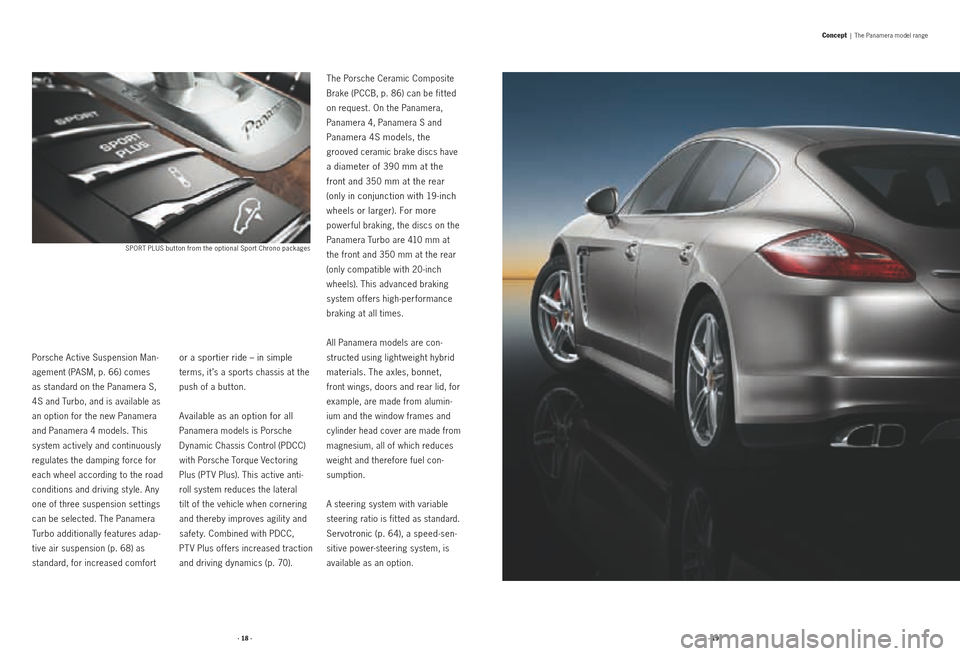
· 18 ·· 19 ·
Porsche Active Suspension Man-
agement (PASM, p. 66) comes
as standard on the Panamera S,
4S and Turbo, and is available as
an option for the new Panamera
and Panamera 4 models. This
system actively and continuously
regulates the damping force for
each wheel according to the road
conditions and driving st yle. Any
one of three suspension set tings
can be selected. The Panamera
Turbo additionally features adap -
tive air suspension (p. 68) as
standard, for increased comfort or a sportier ride – in simple
terms, it ’s a sports chassis at the
push of a but ton.
Available as an option for all
Panamera models is Porsche
Dynamic Chassis Control (PDCC)
with Porsche Torque Vectoring
Plus (PT V Plus). This active anti-
roll system reduces the lateral
tilt of the vehicle when cornering
and thereby improves agilit y and
safet y. Combined with PDCC,
PT V Plus of fers increased traction
and driving dynamics (p. 70). The Porsche Ceramic Composite
Brake (PCCB, p. 86) can be fit ted
on request. On the Panamera,
Panamera 4, Panamera S and
Panamera 4S models, the
grooved ceramic brake discs have
a diameter of 390 mm at the
front and 350 mm at the rear
(only in conjunction with 19-inch
wheels or larger). For more
powerful brak ing, the discs on the
Panamera Turbo are 410 mm at
the front and 350 mm at the rear
(only compatible with 20 -inch
wheels). This advanced braking
system of fers high -performance
braking at all times.
All Panamera models are con -
structed using light weight hybrid
materials. The axles, bonnet,
front wings, doors and rear lid, for
example, are made from alumin -
ium and the window frames and
cylinder head cover are made from
magnesium, all of which reduces
weight and therefore fuel con -
sumption.
A steering system with variable
steering ratio is fit ted as standard.
Servotronic (p. 64), a speed-sen -
si
tive power-steering system, is
available as an option.
Concept | The Panamera model range
SPORT PLUS but ton from the optional Sport Chrono packages
Page 12 of 80
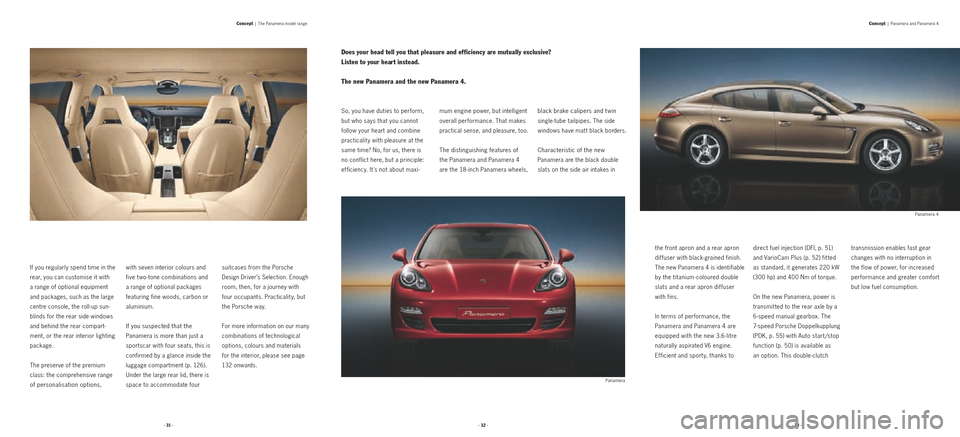
· 31 ·· 32 ·· 33 ·
If you regularly spend time in the
rear, you can customise it with
a range of optional equipment
and packages, such as the large
centre console, the roll-up sun-
blinds for the rear side windows
and behind the rear compart -
ment, or the rear interior lighting
package.
The preserve of the premium
class: the comprehensive range
of personalisation options,
with seven interior colours and
five t wo -tone combinations and
a range of optional packages
featuring fine woods, carbon or
aluminium.
If you suspected that the
Panamera is more than just a
sportscar with four seats, this is
confirmed by a glance inside the
luggage compartment (p. 126).
Under the large rear lid, there is
space to accommodate four suitcases from the Porsche
Design Driver’s Selection. Enough
room, then, for a journey with
four occupants. Practicalit y, but
the Porsche way.
For more information on our many
combinations of technological
options, colours and materials
for the interior, please see page
132 onwards.
Concept | The Panamera model range
So, you have duties to perform,
but who says that you cannot
follow your heart and combine
practicalit y with pleasure at the
same time? No, for us, there is
no conflict here, but a principle:
efficiency. It's not about maxi -
Does your head tell you that pleasure and efficiency are mutually exclusive?
Listen to your heart instead.
The new Panamera and the new Panamera 4.
mum engine power, but intelligent
overall performance. That makes
practical sense, and pleasure, too.
The distinguishing features of
the Panamera and Panamera 4
are the 18-inch Panamera wheels,
black brake calipers and t win
single-tube tailpipes. The side
windows have mat t black borders.
Characteristic of the new
Panamera are the black double
slats on the side air intakes in
the front apron and a rear apron
dif fuser with black-grained finish.
The new Panamera 4 is identifiable
by the titanium - coloured double
slats and a rear apron dif fuser
with fins.
In terms of performance, the
Panamera and Panamera 4 are
equipped with the new 3.6 - litre
naturally aspirated V6 engine.
Ef ficient and sport y, thanks to direct fuel injection (DFI, p. 51)
and VarioCam Plus (p. 52) fit ted
as standard, it generates 220 kW
(300 hp) and 400 Nm of torque.
On the new Panamera, power is
transmit ted to the rear axle by a
6 -speed manual gearbox. The
7-speed Porsche Doppelkupplung
(PDK, p. 55) with Auto start /stop
function (p. 50) is available as
an option. This double- clutch transmission enables fast gear
changes with no interruption in
the flow of power, for increased
performance and greater comfort
but low fuel consumption.
Panamera 4
Panamera
Concept | Panamera and Panamera 4
Page 14 of 80

· 36 ·· 37 ·
You could choose to drive a sport y
saloon. Or a sport y MPV. Alterna -
tively, you could choose to drive a
four-seater Porsche. Just like the
Panamera S or Panamera 4S, with
per formance figures to match
many a sport y t wo -seater.
The S models are recognisable by
the silver- coloured brake calipers
behind the 18-inch Panamera S
wheels and by their round t win
Four doors.
But a classic sportscar nonetheless.
The Panamera S and the Panamera 4S.
tailpipes. The side windows have
a chrome- coloured border. In the
interior, the silver- coloured rev
counter dial is visually striking.
On the Panamera S, the double
slats on the side air intakes are
black. On the Panamera 4S, they
are titanium-coloured.
Both models have a 4.8-litre
naturally aspirated V8 engine that
produces 294 kW (400 hp)
and 500 Nm of torque. On the
Panamera S, power is transmit ted
to the rear wheels by the standard
6 -speed manual gearbox. The
7-speed Porsche Doppelkupplung
(PDK) is available as an option. On
the Panamera 4S, PDK is standard
and transmits drive force to the
all-wheel drive of Porsche Trac-
tion Management (PTM, p. 60) –
also fit ted as standard. The Panamera S accelerates from
0 to 62 mph (100 km/ h) in just
5.6 seconds, with a top speed of
177 mph (285 km/ h). With the
optional PDK, figures of 5.4
sec
-
onds and 176 mph (283 km/ h)
are
achieved. The Panamera 4S
completes the sprint in only
5.0 seconds and has a top speed
of 175 mph (282 km/ h).
Steel spring suspension with
Porsche Active Suspension Man -
agement
(PASM, p. 66) is fit ted as
standard in both models. Adaptive
air suspension, 20 -inch wheels
and a sports exhaust system are
just three of many options you can
select to personalise your vehicle.
Safet y features include Bi-Xenon
headlights with dynamic range
adjustment (p. 80), which provide
more effective illumination of
the road and are fit ted as stand -
ard on both models. Also standard
is Tyre Pressure Monitoring (TPM,
p. 65) and the automatically
dimming mirrors.
A high level of interior comfort is
assured by the automatic climate control system and the heated
seats fit ted as standard in the
front, with seat heating optional
for the rear. Seat ventilation is
available on request. The partial
leather interior has the same
specification as for the Panamera/
Panamera 4.
Porsche Communication Mana -
gement (PCM) with navi gation
module is standard on both the Panamera S and Panamera 4S.
The BOSE
® Surround Sound
System (p. 114) or Burmester
®
High-End Surround Sound System
(p. 116) are both optional.
These options are only the
be ginning when it comes to
customising the Panamera S or
4S. Give your four-seater Porsche
your ver y own personal touch.
Panamera S Panamera 4S with sports exhaust system and 20 - inch RS Spyder Design wheels
Concept
| Panamera S and Panamera 4S
Page 18 of 80
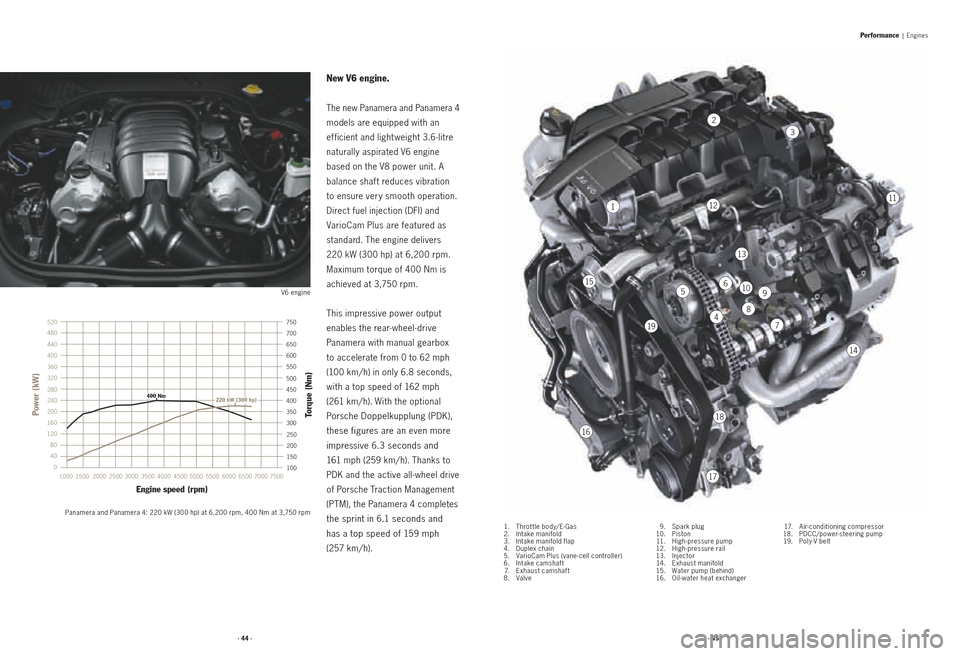
· 44 ·· 45 ·
2
3
11112
13
1561059
84197
14
18
16
17
Performance | Engines
V6 engine
Panamera and Panamera 4: 220 kW (300 hp) at 6,200 rpm, 400 Nm at 3,750 rpm
New V6 engine.
The new Panamera and Panamera 4
models are equipped with an
ef ficient and light weight 3.6 -litre
naturally aspirated V6 engine
based on the V8 power unit. A
balance shaft reduces vibration
to ensure very smooth operation.
Direct fuel injection (DFI) and
VarioCam Plus are featured as
standard. The engine delivers
220 kW (300 hp) at 6,200 rpm.
Maximum torque of 400 Nm is
achieved at 3,750 rpm.
This impressive power output
enables the rear-wheel- drive
Panamera with manual gearbox
to accelerate from 0 to 62 mph
(100 km/ h) in only 6.8 seconds,
with a top speed of 162 mph
(261 km/ h). With the optional
Porsche Doppelkupplung (PDK),
these figures are an even more
impressive 6.3 seconds and
161 mph (259 km/ h). Thanks to
PDK and the active all-wheel drive
of Porsche Traction Management
(PTM), the Panamera 4 completes
the sprint in 6.1 seconds and
has a top speed of 159 mph
(257 km/ h).
1. Throt tle body/ E- Gas
2. Intake manifold
3. Intake manifold flap
4. Duplex chain
5. VarioCam Plus (vane - cell controller)
6. Intake camshaf t
7. Exhaust camshaf t
8. Valve
9. Spark plug
10. P i s t o n
11. High - pressure pump
12. High - pressure rail
13. Injector
14. Exhaust manifold
15. Water pump (behind)
16. Oil -water heat exchanger
17. Air-conditioning compressor
18. PDCC/power-steering pump
19. Poly-V belt
100
300 350
400
450
500 550 600
650
160
120
1
80
140
100
200 240 280 320 360
400
4401500
7500
2000 2500 3000 3500 4000 4500 5000 5500 6000 6500 7000 150 200
2501000
480
700
520
750
400 Nm
200 205
210
215
220
225
230
235
240
245
250
255
260
265
270
275
280
285
290
295
300
40
60
80
100
120
140
160
180
200
220
240
260
280
300
320
340
360
380
400
420
440
500 1000 1500 2000 2500 3000 3500 4000 4500 5000 5500 6000 6500 7000
eff. red. Leistung [kW] eff. red. Drehmoment EWG [Nm]
Drehzahl [U/min]
Panamera V6 BDE 3,6l
Vollastkurve
Pemax. = 221 kW (300 PS) bei 6250 1/min
Md
max. = 400 Nm bei 4250 1/min
220 kW (300 hp)
Power (kW)
Engine speed (rpm)
Torque (Nm)
Page 19 of 80
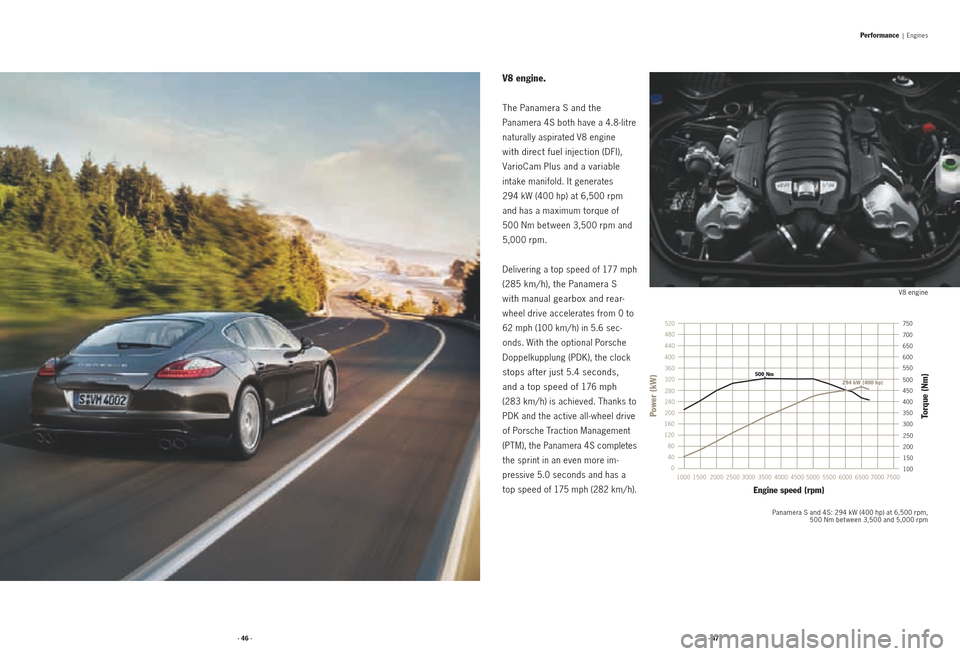
· 46 ·· 47 ·
V8 engine
Panamera S and 4S: 294 kW (400 hp) at 6,500 rpm, 500 Nm bet ween 3,500 and 5,000 rpm
V8 engine.
The Panamera S and the
Panamera 4S both have a 4.8-litre
naturally aspirated V8 engine
with direct fuel injection (DFI),
VarioCam Plus and a variable
intake manifold. It generates
294 kW (400 hp) at 6,500 rpm
and has a maximum torque of
500 Nm bet ween 3,500 rpm and
5,000 rpm.
Delivering a top speed of 177 mph
(285 km/ h), the Panamera S
with manual gearbox and rear-
wheel drive accelerates from 0 to
62 mph (100 km/ h) in 5.6 sec -
onds. With the optional Porsche
Doppelkupplung (PDK), the clock
stops after just 5.4 seconds,
and a top speed of 176 mph
(283 km/ h) is achieved. Thanks to
PDK and the active all-wheel drive
of Porsche Traction Management
(PTM), the Panamera 4S completes
the sprint in an even more im -
pressive 5.0 seconds and has a
top speed of 175 mph (282 km/ h).
100
300 350
400
450
500 550 600
650
160
120
1
80
140
100
200 240 280 320 360
400
4401500
7500
2000 2500 3000 3500 4000 4500 5000 5500 6000 6500 7000 150 200
2501000
480
700
520
750
294 kW (400 hp)500 Nm
Power (kW)
Engine speed (rpm)
Torque (Nm)
Performance | Engines
Page 29 of 80

· 66 ·· 67 ·
Standard in the Panamera S, 4S
and Turbo and optional for the
Panamera and Panamera 4, PASM
is an electronic damping control
system which of fers continuous
adjustment of the damping forces
according to the road conditions
and driving st yle.
Designed to operate in accord-
ance with the skyhook principle, the suspension acts to keep the
body stable. This reduces body
movement and thus increases
comfort in each of the four seats.
Using a separate but ton on the
centre console, the driver can
select bet ween three modes:
‘Comfort ’, ‘SPORT’ or ‘SPORT
PLUS’. Sensors record the body
movements that accompany powerful acceleration, braking
and rapid cornering or uneven
road surfaces.
Signals such as lateral accel-
eration, steering angle, brake
pressure and engine torque are
also analysed. The PASM control
unit evaluates the driving condi
-
tions and modifies the damping
force on each of the wheels
in accordance with the selected
mode.
For your safet y, PASM contin -
uously monitors the driving condi -
tions. If you are driving in ‘Comfort ’
mode and suddenly adopt a
sportier and more dynamic driving
st yle, the system automatically
switches to a harder rating within
the ‘Comfort ’ setup range to
increase driving stabilit y and
safet y. If, in ‘SPORT’ or ‘SPORT PLUS’
mode, the qualit y of the road
sur face drops below a certain
threshold, PASM immediately
switches to
a softer rating within
the setup range to optimise
traction and grip. As soon as
the road surface improves, the
system reverts to the original
harder rating.
This may sound rather compli
-
cated, but for you it involves
nothing more than the press of a
but ton. And you can feel the
result: increased driving stabilit y,
more comfort and improved
performance.
Performance
| Chassis
The road to success is rarely a smooth one.
Porsche Active Suspension Management (PASM).
Continuous adjustment based on load and speed
Page 31 of 80

· 70 ·· 71 ·
A Porsche holds the road well, its
handling is sport y and precise –
but you’ve known this for a long
time.
What you might not know is
that, with the optional Porsche
Dynamic Chassis Control (PDCC)
with Porsche Torque Vectoring
Plus (PT V Plus), road holding can
be even further improved in all the Panamera models for even more
dynamic per formance and
increased comfort.
PDCC is an active anti-roll system
that anticipates and significantly
reduces lateral body movement
during cornering manoeuvres. In
addition, it minimises the lateral
instabilit y of the vehicle on uneven
ground. The ef fect is achieved with the aid of active anti-roll bars
on the front and rear axles which
respond to the current steering
angle and lateral acceleration
by producing a stabilising force
that precisely negates the roll
of the body.
PT V Plus combined with PDCC is
a system that actively enhances
vehicle dynamics and stabilit y. Operating in conjunction with an
electronically regulated rear dif
-
ferential lock, it works by varying
the torque distribution to the rear
wheels. As a function of steering
angle and steering speed,
accel -
erator pedal position, yaw rate and
vehicle speed, PT V Plus is able
to improve steering response and
steering precision by specific
braking of the right or left rear
wheel.
To be more precise, this means
that when the car is driven asser -
tively into a corner, moderate
brake pressure is applied to the inside rear wheel. Consequently,
a greater amount of drive force is
distributed to the outside rear
wheel, inducing an additional
rotational pulse (yaw movement)
around the vehicle’s vertical axis.
This results in a direct and sport y
steering action as the car enters
the corner.
At low and medium vehicle speeds,
PT V Plus significantly increases
agilit y and steering precision.
At high speeds and when acceler -
ating out of corners, the elec -
tron
ically regulated rear differential
lock ensures greater driving
stabilit y. It also serves to improve
traction at the rear wheels on
road surfaces with varying levels
of grip as well as on snow and ice.
For the driver, this means remark -
able stabilit y and easier handling,
optimum traction, and greater
agilit y at every speed with precise
steering and stable load transfer
characteristics. The result is
a high level of driving pleasure.
Rapid cornering in the Panamera Turbo with PDCC (illustrative example)
Rapid cornering in the Panamera S without PDCC (illustrative example)
Performance | Chassis
A wavering course was never your thing.
Porsche Dynamic Chassis Control (PDCC)
with Porsche Torque Vectoring Plus (PTV Plus).
Page 32 of 80
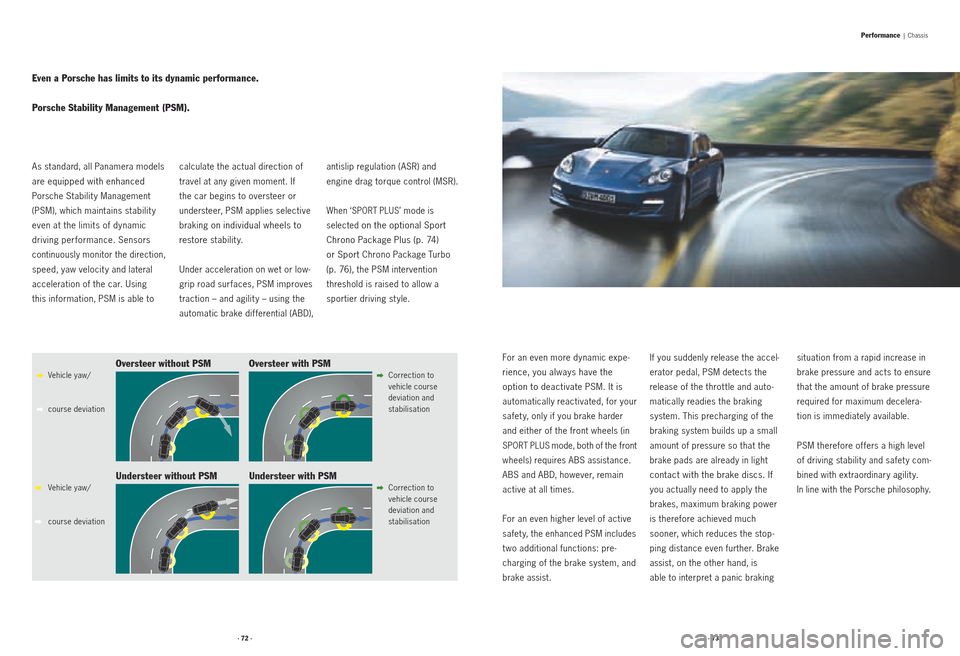
· 72 ·· 73 ·
Vehicle yaw/
course deviation
Vehicle yaw/
course deviationCorrection to
vehicle course
deviation and
stabilisation
Correction to
vehicle course
deviation and
stabilisationOversteer without PSM Oversteer with PSM
Understeer with PSM
Understeer without PSM
Performance | Chassis
As standard, all Panamera models
are equipped with enhanced
Porsche Stabilit y Management
(PSM), which maintains stabilit y
even at the limits of dynamic
driving per formance. Sensors
continuously monitor the direction,
speed, yaw velocit y and lateral
acceleration of the car. Using
this information, PSM is able to calculate the actual direction of
travel at any given moment. If
the car be gins to oversteer or
understeer, PSM applies selective
braking
on individual wheels to
restore
stabilit y.
Under acceleration on wet or low-
grip road surfaces, PSM improves
traction – and agilit y – using the
automatic brake dif ferential (ABD), antislip regulation (ASR) and
engine drag torque control (MSR).
When ‘SPORT PLUS’ mode is
selected
on the optional Sport
Chrono Package Plus (p. 74)
or Sport
Chrono Package Turbo
(p. 76), the PSM intervention
threshold is raised to allow a
sportier driving st yle.
For an even more dynamic expe-
rience, you always have the
option to deactivate PSM. It is
automatically reactivated, for your
safet y, only if you brake harder
and either of the front wheels (in
SPORT PLUS mode, both of the front
wheels) requires ABS assistance.
ABS and ABD, however, remain
active at all times.
For an even higher level of active
safet y, the enhanced PSM includes
t wo additional functions: pre -
charging of the brake system, and
brake assist. If you suddenly release the accel
-
erator pedal, PSM detects the
release of the throt tle and auto -
matically readies the braking
system. This precharging of the
braking system builds up a small
amount of pressure so that the
brake pads are already in light
contact with the brake discs. If
you actually need to apply the
brakes, maximum braking power
is therefore achieved much
sooner, which reduces the stop -
ping distance even further. Brake
assist, on the other hand, is
able to interpret a panic braking situation from a rapid increase in
brake pressure and acts to ensure
that the amount of brake pressure
required for maximum decelera
-
tion is immediately available.
PSM therefore of fers a high level
of driving stabilit y and safet y com -
bined with extraordinary agil
it y.
In line with the Porsche philosophy.
Even a Porsche has limits to its dynamic performance.
Porsche Stability Management (PSM).
Page 34 of 80
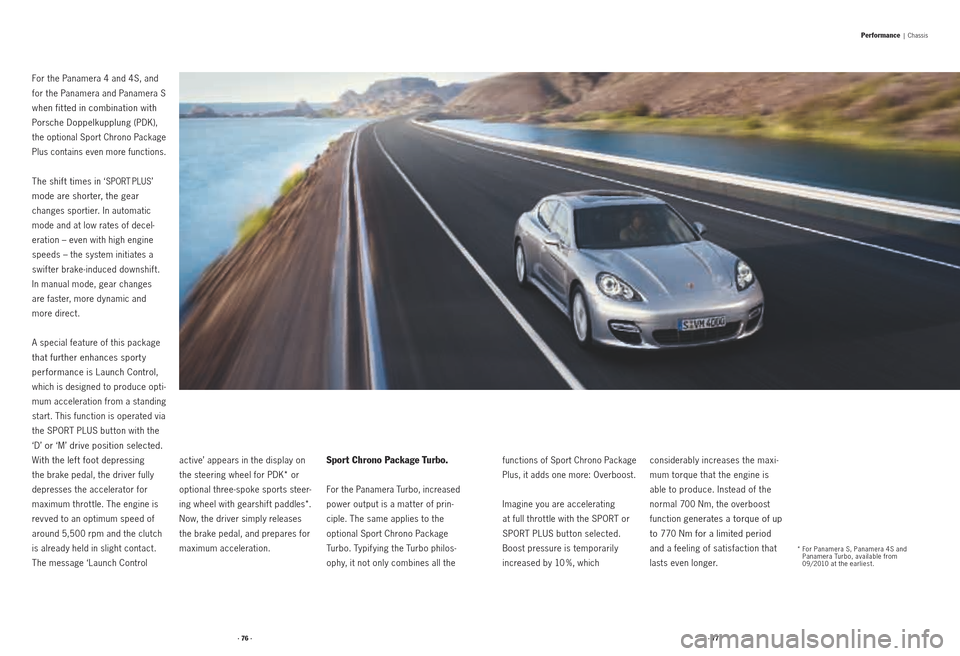
· 76 ·· 77 ·
For the Panamera 4 and 4S, and
for the Panamera and Panamera S
when fit ted in combination with
Porsche Doppelkupplung
(PDK),
the optional Sport Chrono Package
Plus contains even more functions.
The shift times in ‘SPORT PLUS’
mode are shorter, the gear
changes sportier. In automatic
mode and at low rates of decel -
eration – even with high engine
speeds – the system initiates a
swif ter brake-induced downshif t.
In manual mode, gear changes
are faster, more dynamic and
more direct.
A special feature of this package
that further enhances sport y
performance is Launch Control,
which is designed to produce opti -
mum acceleration from a standing
start. This function is operated via
the SPORT PLUS but ton with the
‘D’ or ‘M’ drive position selected.
With the left foot depressing
the brake pedal, the driver fully
depresses the accelerator for
maximum throt tle. The engine is
rev ved to an optimum speed of
around 5,500 rpm and the clutch
is already held in slight contact.
The message ‘Launch Control active’ appears in the display on
the steering wheel for PDK* or
optional three-spoke sports steer
-
ing wheel with gearshif t paddles*.
Now, the driver simply releases
the brake pedal, and prepares for
maximum acceleration.
Sport Chrono Package Turbo.
For the Panamera Turbo, increased
power output is a mat ter of prin -
ciple. The same applies to the
optional Sport Chrono Package
Turbo. Typifying the Turbo philos -
ophy, it not only combines all the
functions of Sport Chrono Package
Plus, it adds one more: Overboost.
Imagine you are accelerating
at full throt tle with the SPORT or
SPORT PLUS but ton selected.
Boost pressure is temporarily
increased by 10 %, which considerably increases the maxi -
mum torque that the engine is
able to produce. Instead of the
normal 700 Nm, the overboost
function
generates a torque of up
to 770 Nm for a limited period
and
a feeling of satisfaction that
lasts even longer.
Performance | Chassis
* For Panamera S, Panamera 4S and
Panamera Turbo, available from
09/2010 at the earliest.